Plant a Bee Carpet
- Anno Torr
- May 29
- 8 min read
Carpet: a floor covering made from thick woven fabric.

Imagine a floral carpet fragrant with the scent of citrus, mint, and jasmine rather than of wet dog and smelly feet! Heaven – and just the scents to excite our struggling bees, too, for flower fragrance and colour are two important signals evolved by plants to attract pollinators. So, let’s take this carpet out into the garden where we’ll focus on a mix of low-growing nectar- and pollen-rich groundcovers.
But first, to unpack a few interesting facts about bees and their needs:
• Most bees are generalists, visiting a wide variety of plants throughout the year.
• Nectar is a bee’s main source of energy as it is high in sugar, while pollen provides proteins and fats that balance the diet.
• Gathering pollen to take back to the hives is labour-intensive, so bees are on the lookout for suitable flowers as close to home as possible. And, if there is a spread of flowers rather than the odd few dotted around, so much the better, for they can collect their fill while saving flying time and energy searching out others. For the gardener, though, it is often difficult to know where the bees are nesting, so the best option is to spread your flower displays around the garden.
How bees choose flowers:
Flowers have evolved to produce fragrance, bright colours, nectar, and pollen signals to attract pollinators. Most importantly, flower attractions need to excite bees enough to ensure repeat visits.
Pollen: Specialists are still unsure which properties of pollen the bees respond to. What is known is that these insects evaluate both the sugar content and the flow rate of nectar as they collect it. But, as the bees only taste the pollen once they’ve carried it back to the hive to feed the entire colony, how they assess the nutritional content (protein content) is unclear.
Taste and Smell: Certain taste receptors can detect the sugar content, but they respond to fragrance as well, and the smell of pollen differs from that of the flower as a whole. From a plant’s perspective, manufacturing pollen is energy-intensive, and research suggests that plants control the amount of pollen taken by bees through taste.
Visual cues are numerous: bees decode signals that indicate how much pollen is being released by the flower, they assess the size of pollen grains, and, new research shows, even detect electric fields around flowers. Response to colour is well-documented, with the blue, purple, violet, white and yellow spectrum being the most popular.
Experience or learning: studies suggest that the foraging habits of social bees are influenced by feedback from members of the colony, plus, just how well stocked is the larder!
What hinders a bee’s search for sufficient quality and quantity of food?
Hybrid species often contain reduced volumes and quality of pollen and nectar.
Hybrids with double blooms commonly offer less food, make it difficult for the insects to reach the inner flower, and the extra set of petals commonly replaces the pollen-laden anthers. So, rather stick with the original species.
Don’t use pesticides. Most pesticides are not selective.
Where to place your flower carpet:
Sunny spots are best, as most plants flower more prolifically in sunlight. Flower and leaf fragrance is often stronger in the heat of the day, especially those whose leaves are high in aromatic oils, like the Salvia/ mint family. Tuck these carpets out of the path of strong winds that rob them of the energy they need to feed, collect and fly back home with full pollen pouches. Have we mentioned this is not a foot-friendly carpet? Place it off the pathway, and anywhere little feet might wander; add it as an edging to an existing flower bed where bee-friendly perennials will increase diversity and choice. When encircled or at least backed by taller species, it can offer the bees a wind-free feeding zone.
Design:
A carpet made up of a single species or an intermingling design with two or more, the choice is yours. The latter, though, requires some thought and knowledge of plants' competitiveness; don’t combine slow-growing groundcovers with more vigorous species that might smother them. Match water needs: look at rainfall season and volumes required – low, moderate, high. Use groundcovers that spread quickly and are known to cover vast areas, like Carpobrotus, as single-species carpets where they can spread around and beneath taller perennials, subshrubs, and succulents.
Management:
The idea is to keep plants flowering, so deadhead groundcovers continually through the season, and keep them in the peak of health with handfuls of compost mulch.
Plants for your Flower Carpet design:
Arctotis arctotoides: Botterblom
A fast-growing, soft, herbaceous groundcover with butter-yellow flowers for much of the year. Attractive leaves with undulating margins, light green and hairy. Flowers stand about 20 cm above the foliage. Common on disturbed roadside verges. Bees are the main pollinators. Soil: most types, from clay to sand. Water needs: low to high. Size: each plant grows quickly to cover a 60 cm area. Replace plants after 3 – 4 years.
Arctotis stoechadifolia: Silver Arctotis; Coast Arctotis; Bittergousblom
A fast-spreading groundcover for sandy to well-draining soils, hot sun and sloping gardens, this plant needs room to spread. Flowers range from cream to light yellow and are bee-pollinated. Though a Western Cape species, they thrive in gardens around the world as long as soils drain well and they’re not over-watered. An excellent plant to hold loose and sandy soils. Protect from frost; plants should regrow from the roots if frost-damaged.
Bulbine frutescens: Stalked Bulbine
Bees love the nectar-rich Bulbine flowers. B. frutescens is a favourite with gardeners around the country for its easy-care attributes. This is a most attractive groundcover for hot, sunny beds and sandy or well-draining soils. Relatively fast-growing. Plant a mix of the yellow and orange flowered varieties. Plants become woody over time and need replacing.
Carpobrotus dimidiata: Sour Fig
A fast-spreading succulent for large areas. Similar to the Cape Fig, with purple flowers and a more rampant growth habit.
Carpobrotus edulis: Sour Fig; Cape Fig
Easy-to-grow, low-maintenance and water-wise, who could ask for anything more? Add large pale yellow flowers for bees, gel for the first-aid kit, and edible fruits, and this is a winner for Cape gardens. Plants flower from late winter through spring. Water needs: low.
Chaenostoma pauciflora: Trailing Phlox
An attractive trailing groundcover for both full sun and partial shade with dark green leaves, small white flowers from September to April, and a neat growth habit. 10 cm high plants spread up to 45 cm. From the Northern and Western Cape. Plants are bee-pollinated. Water needs: low to moderate.
Cotula sericea: Silky Buttons
A fast-growing, spreading groundcover with fine-textured apple to grey-green leaves. Small yellow buttons stand well above the leaves, prolific in spring and early summer, and intermittently throughout the year. Plants can withstand fairly long, dry periods if happy with their growing conditions, but do best with regular watering, so you’ll need to experiment a bit to work out the best water regime in your micro-climate. Despite this, plants are easy and rewarding to grow. Use to cover a large area, mix with other fine-leaf species like Geranium incanum, or add to a mixed container display.
Crassothonna cacalioides: Othonna
Othonna is a spreading, ground-hugging succulent with small yellow flowers held above the leaves on slender stalks. Flowering is mainly from April to October, but it often has flowers throughout the year. This little plant provides effective and rapid cover on large, dry banks; use it to wash over rocks in a sunny rockery, and provide a water-wise pairing with aloes and other succulents. Plants grow in sun and semi-shaded spots, cope with moderate frost and have low water needs. Flowers attract bees, butterflies and other insects.
Crassula expansa subsp. fragilis:
A gorgeous, dainty-looking herbaceous groundcover for bushveld gardens in the east of the country. Tiny white flowers cover this little succulent like confetti from mid-summer through to winter. Foliage colours red when water-stressed. This is a good choice where soils are shallow and stony. Water needs: low.
Crassula multicava: Fairy Crassula
This commonly used and well-loved groundcover is one of the most valuable species for South African gardeners as it grows in a wide range of situations from partial sun to shade, dry to moist. And in winter, covered in a mass of tiny white and pink stars, it is a favourite with the bees. Water needs: low.
Crassula pellucida subsp. pellucida
Crassula pellucida is a showy, ground-hugging succulent for small areas that forms a soft, apple-green mat of pointed leaves. In spring, an abundance of white star-like flowers open to make this one of the most charming covers for sun and semi-shade. Flowers can be streaked with pink. Plants do prefer dry conditions and have low water needs.
Gazania rigens: Trailing Gazania
A low-growing, trailing perennial groundcover with flowers on and off through the year. Size: 10 – 50 cm. A hardy species for tough situations, with few maintenance requirements and low water needs. Plants form a dense carpet, and flowers are pollinated by bees. G. rigens var. uniflora has bright yellow flowers and silver-grey leaves. G. rigens var. rigens has bright yellow flowers and dark green leaves.
Geranium incanum: Cranesbill
A great choice for a carpet with a fine, airy texture that pops up masses of mauve flowers in spring and summer and on and off through the year. This is another choice for both sun and partially shaded areas, though plants for a tighter carpet in full sun. Use on slopes, in containers and retaining walls, or to edge beds. Water needs: moderate. Frost: moderate to hardy.
Hermmania pinnata: Orange Hermannia; Doll’s Rose; Kwasblaar Kruip Poprosie
This beautiful creeping groundcover (15 cm) is a sight to behold from spring to late summer when it is covered in such an abundance of red-orange drooping bells that the foliage is almost hidden from view. Plants thrive in dry, sandy soils, in rockeries and planted in hot, sun-drenched wall gardens where it forms a cascade of orange bells – an almost unrivalled plant to cover retaining walls. A Western Cape species pollinated by bees. Water-wise, tolerant of winds, but requires some protection from frost.
Otholobium virgatum (= decumbens):
A hardy, decorative ground-hugging plant with dense foliage and masses of pea-like pink/ mauve flowers in spring. A good choice to replace lawn in non-foot-traffic areas. This little groundcover requires decent winter rainfall, well-drained soils and a sunny aspect. A Western Cape and Eastern Cape plant. Water needs: moderate. Use in flower beds, containers, and on slopes. Size: 5 – 15 cm.
Pelargonium reniforme: Kidney-leaved Pelargonium
A gorgeous show-stopper with grey-green, velvet-like leaves and pink-magenta flowers throughout the year. Plants usually grow 30 – 40 cm high. Cover is reasonably tight, but loose enough to allow a mix of other species to share the space. Plants mix well with Gazania, Geranium incanum and Delosperma cooperi. A plant from the Eastern Cape that does well in gardens around the country. Water needs: low to moderate.
Plectranthus neochilus: Lobster Plant
Look no further than this succulent groundcover to colour hot, dry ground through spring and summer. Plants thrive with little maintenance, forming neat, low mounds up to 50 cm high, but will need a light prune after flowering to prevent woodiness and encourage bushy growth. Bees will remain in attendance until flowers die back. Water needs: low. Frost hardy. Read about this plant in The Plant Library
Vygies: Lampranthus and Delosperma
Vygies are the ultimate carpet groundcovers with a tight, dense growth habit. Bees and other insects visit the flowers around midday. Western and Eastern Cape gardeners can look to the Lampranthus species, while summer rainfall gardeners can search out Delosperma varieties most suited to their region. Delosperma rileyi is a mat-forming, spreading groundcover for Limpopo and Mpumalanga gardens. Tiny flowers come in shades of white to peach, providing for bees and other insects throughout spring and summer. Coastal grassland areas can try D. cooperi, luckily quite common in local nurseries. Lampranthus amoenus and L. roseus are two common and popular species whose rich colours are wildly attractive to insect pollinators.


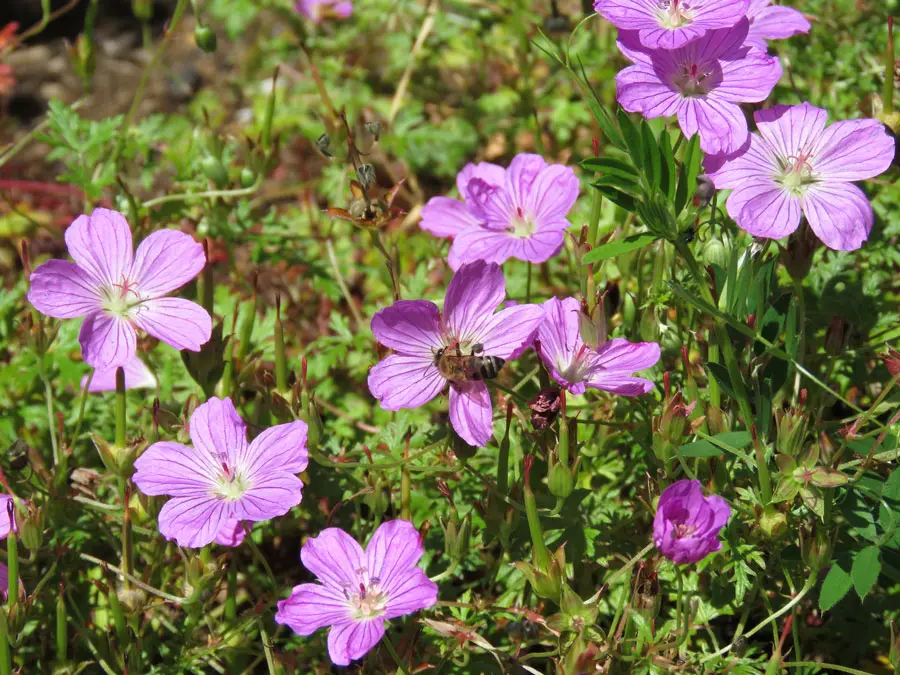
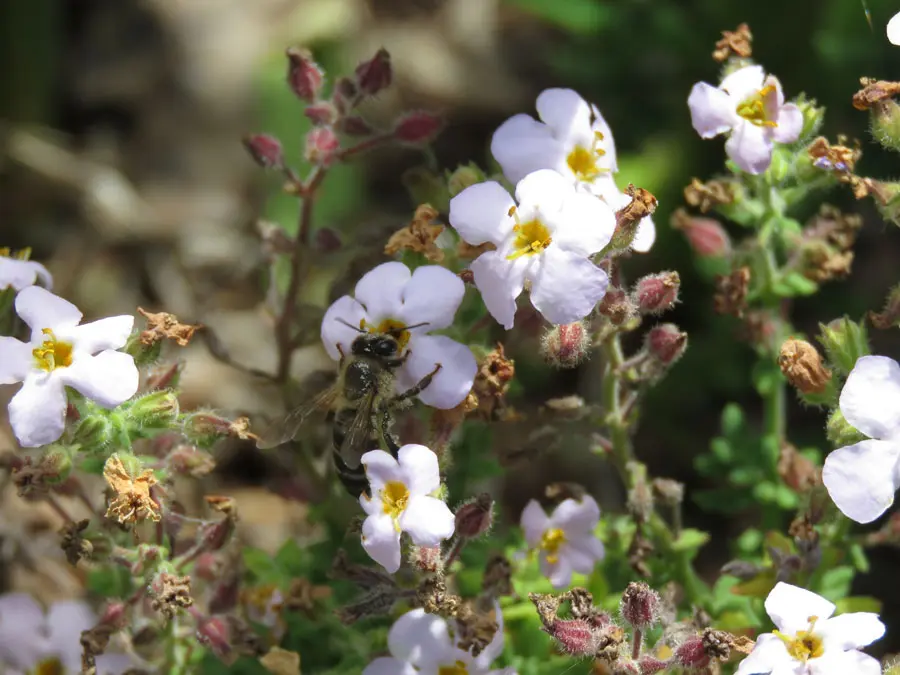
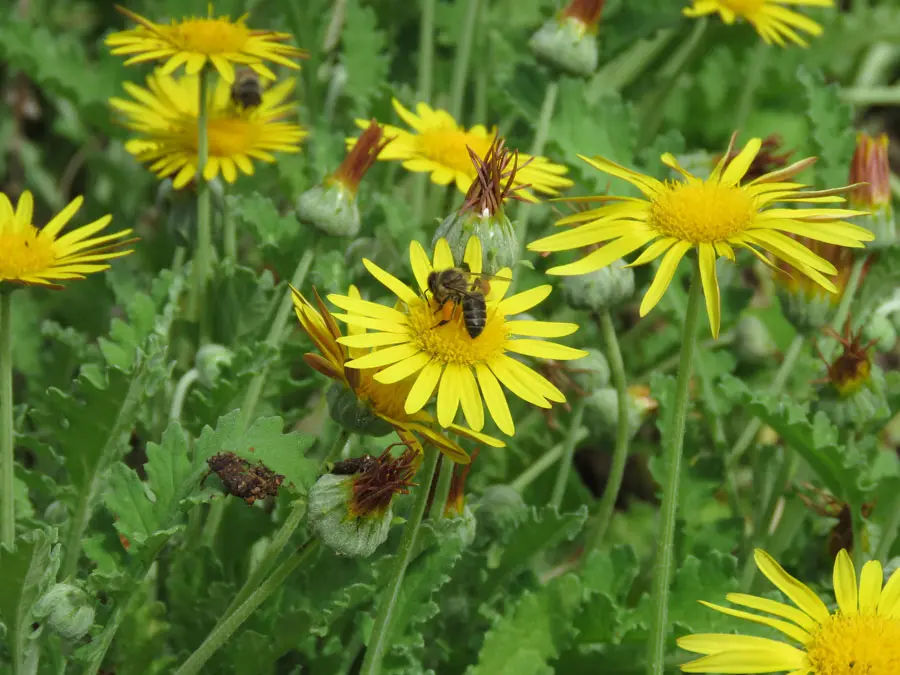
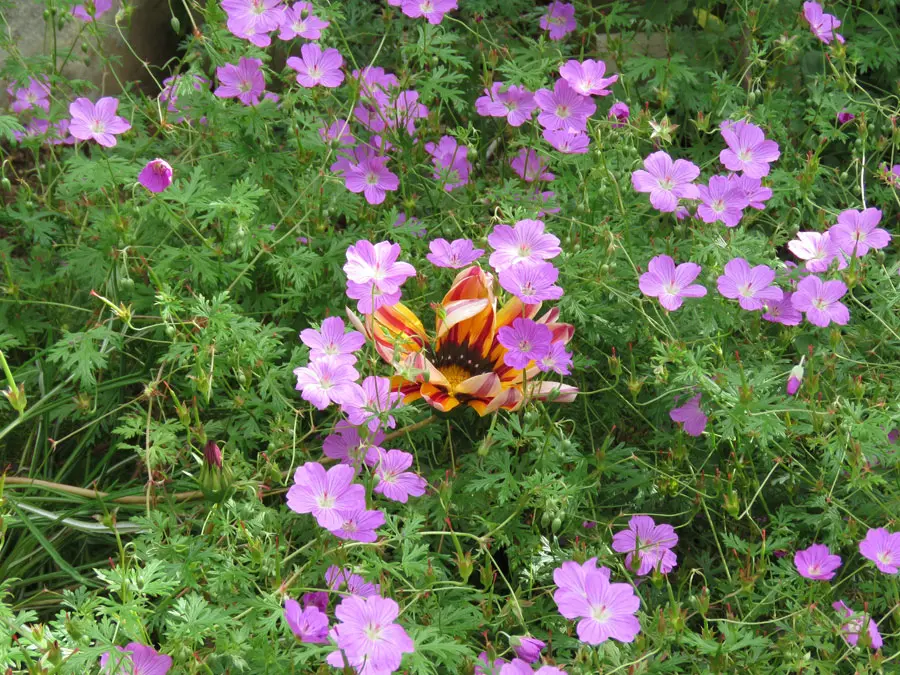
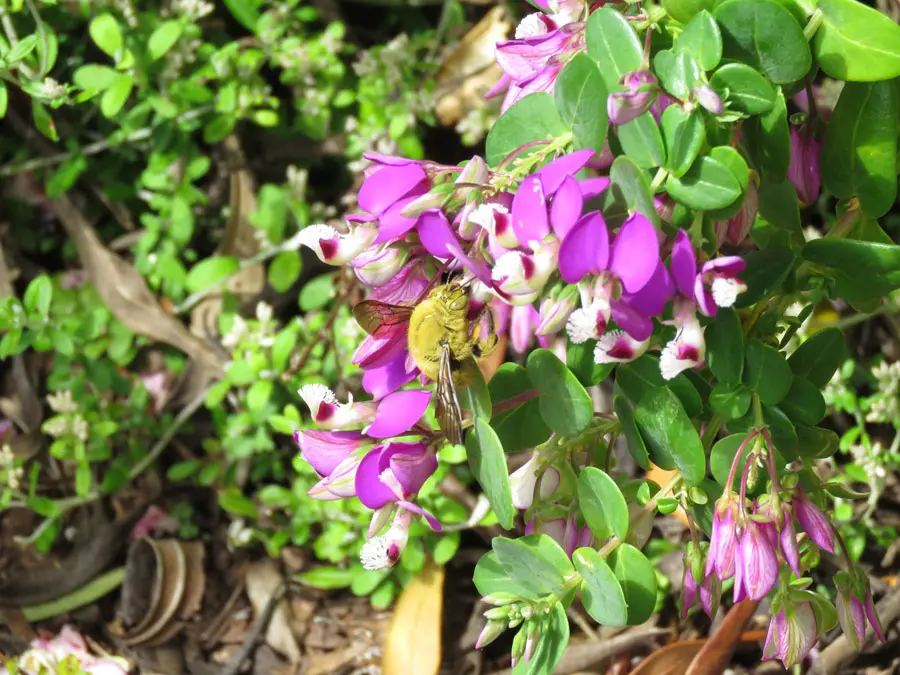
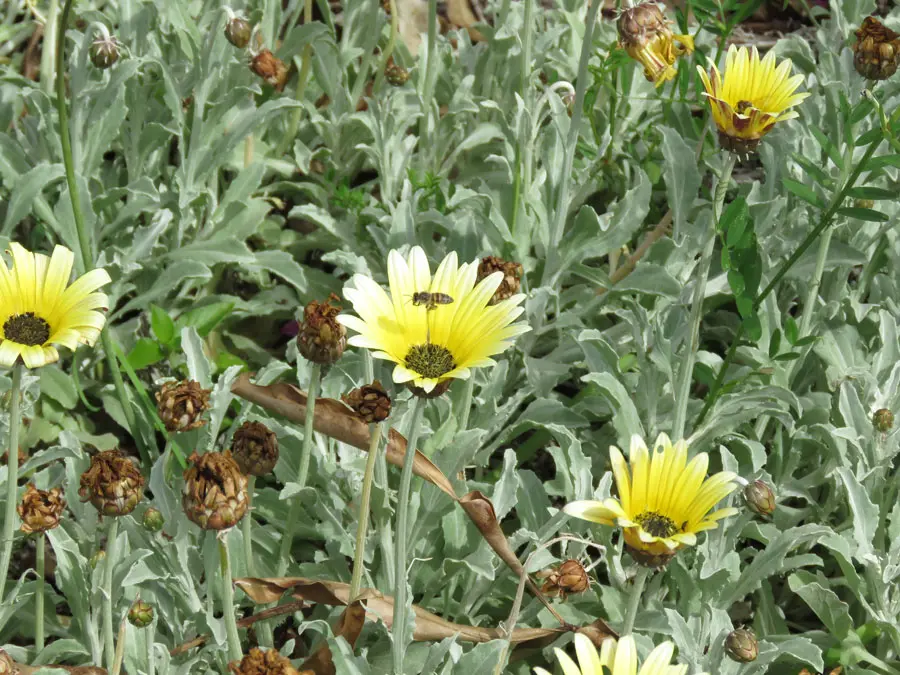



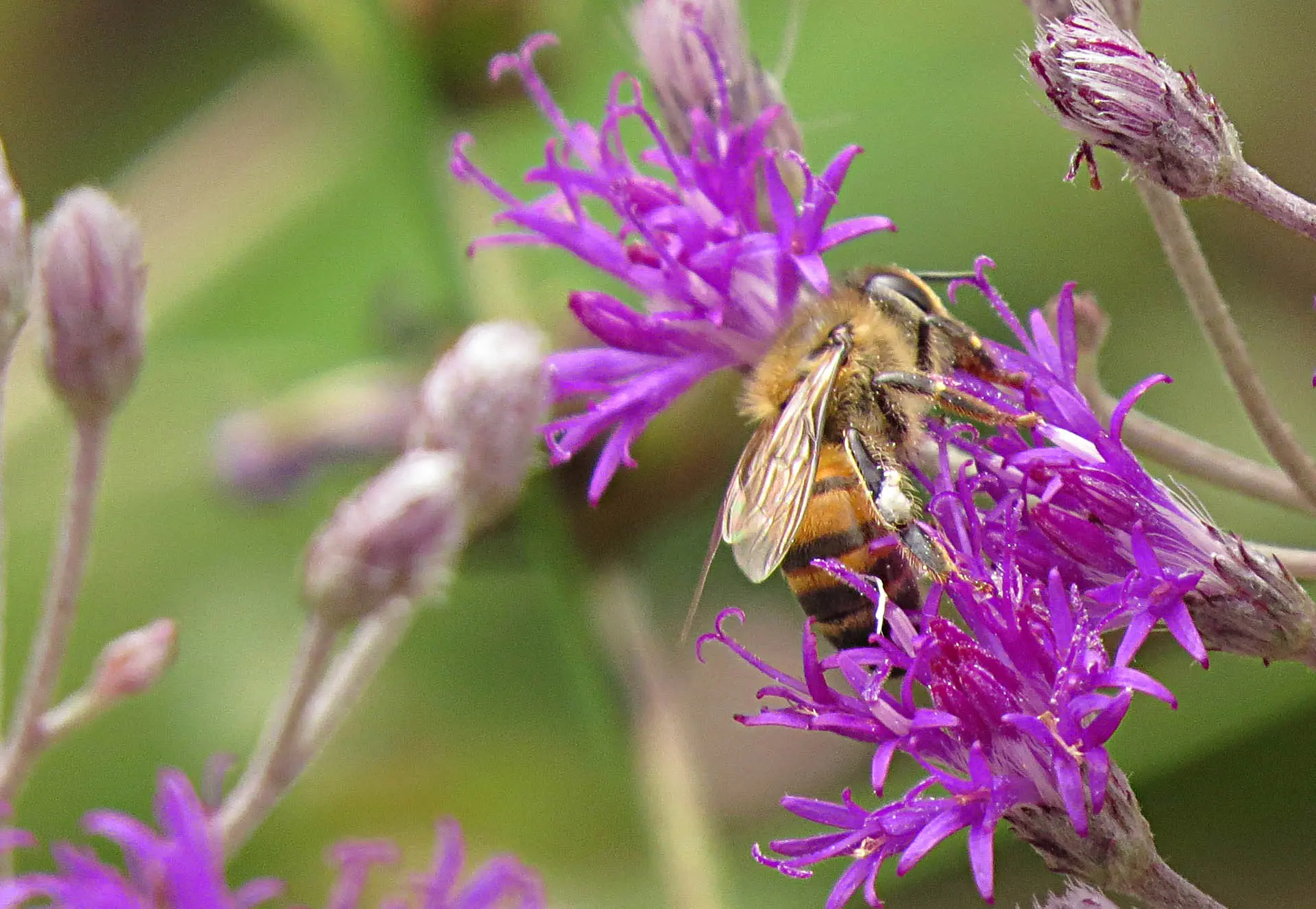
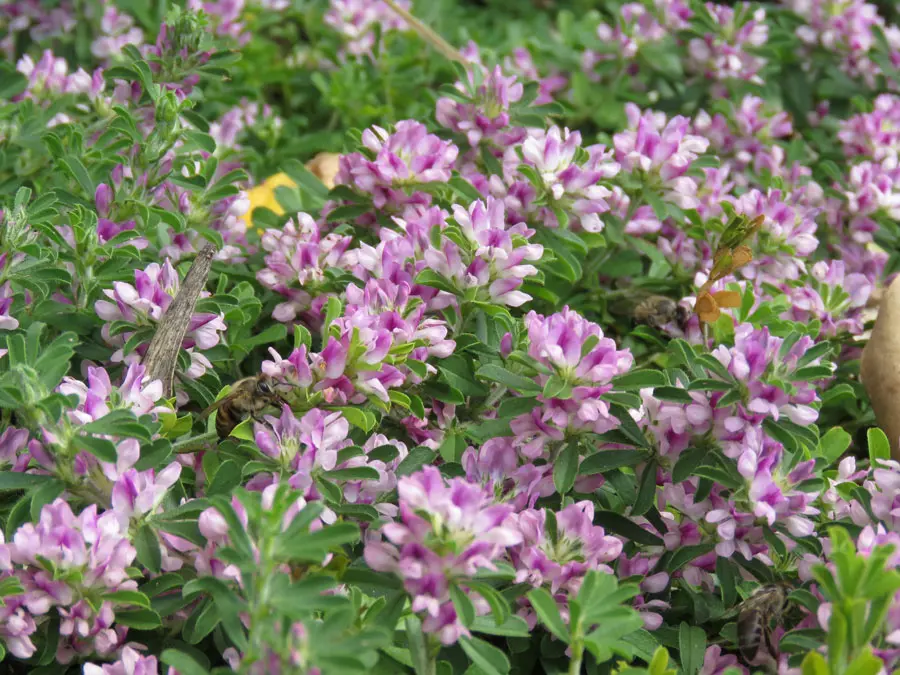
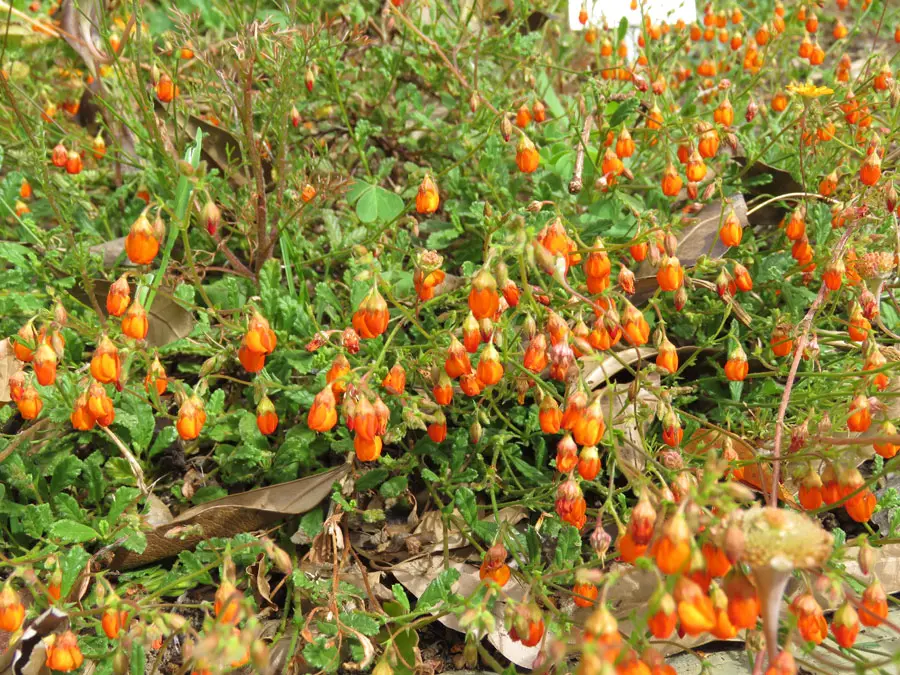
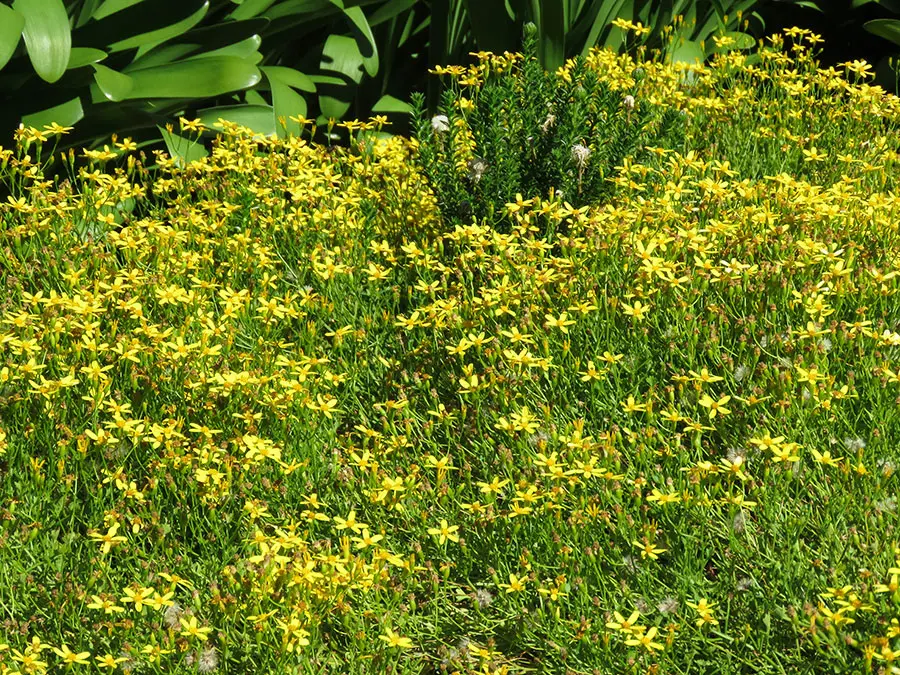
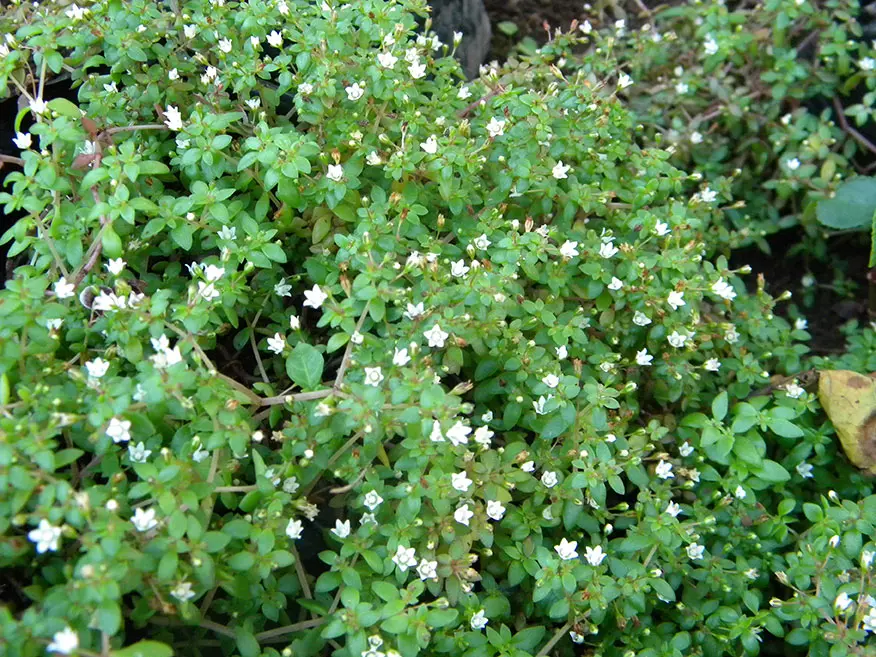
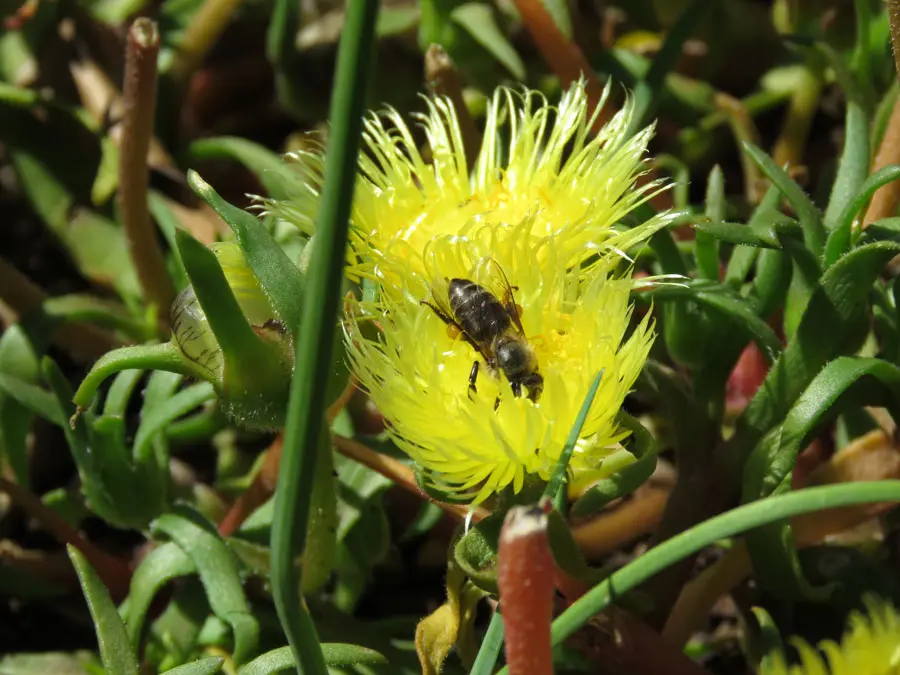
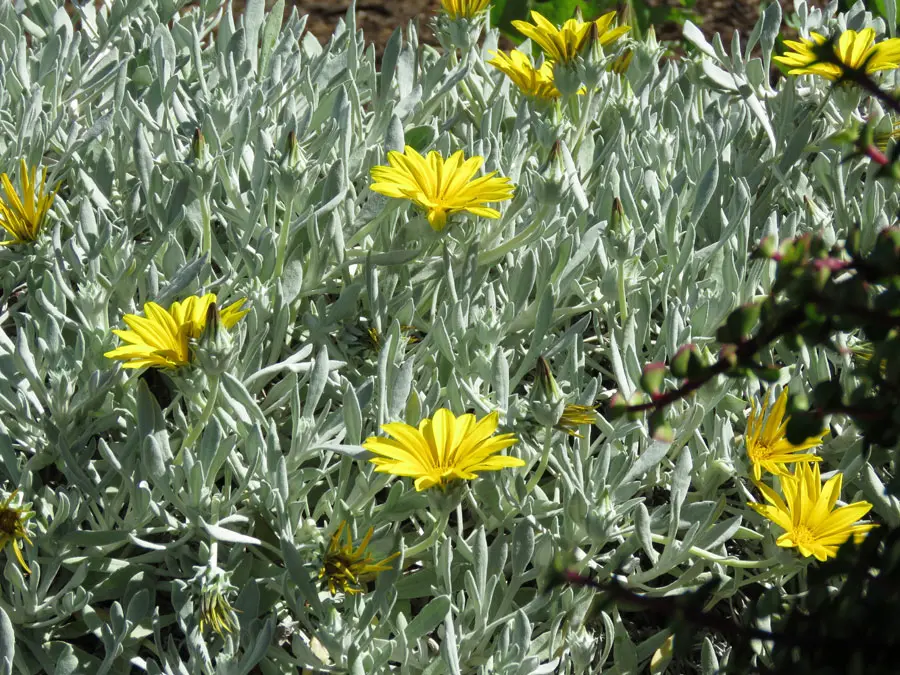
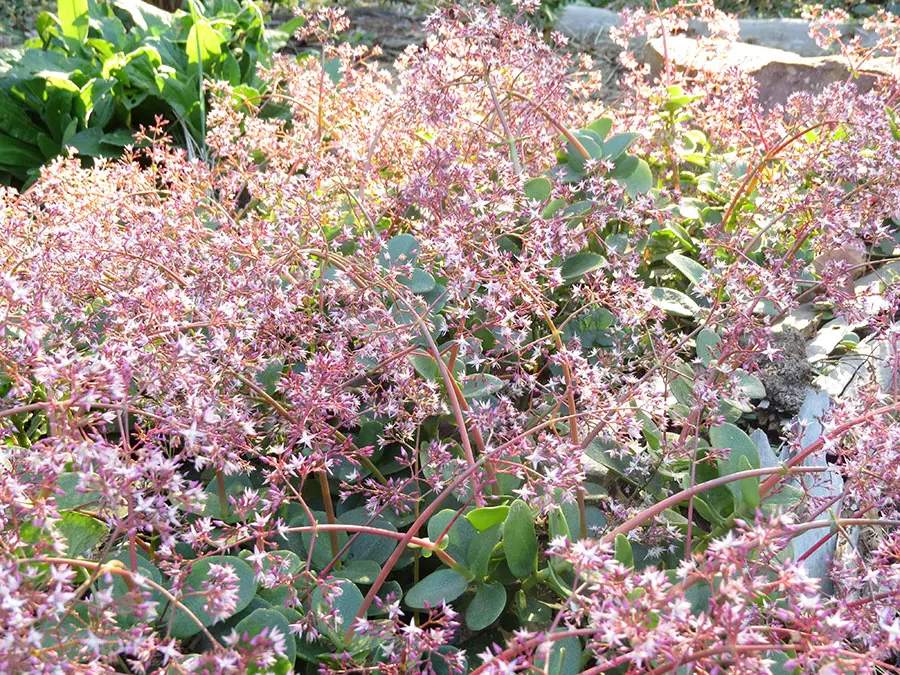
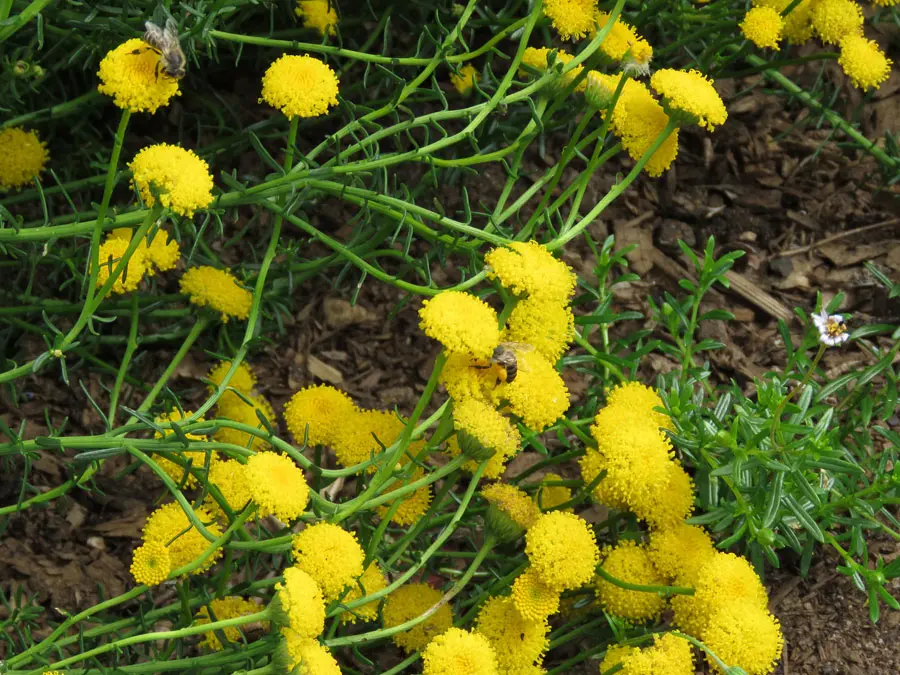
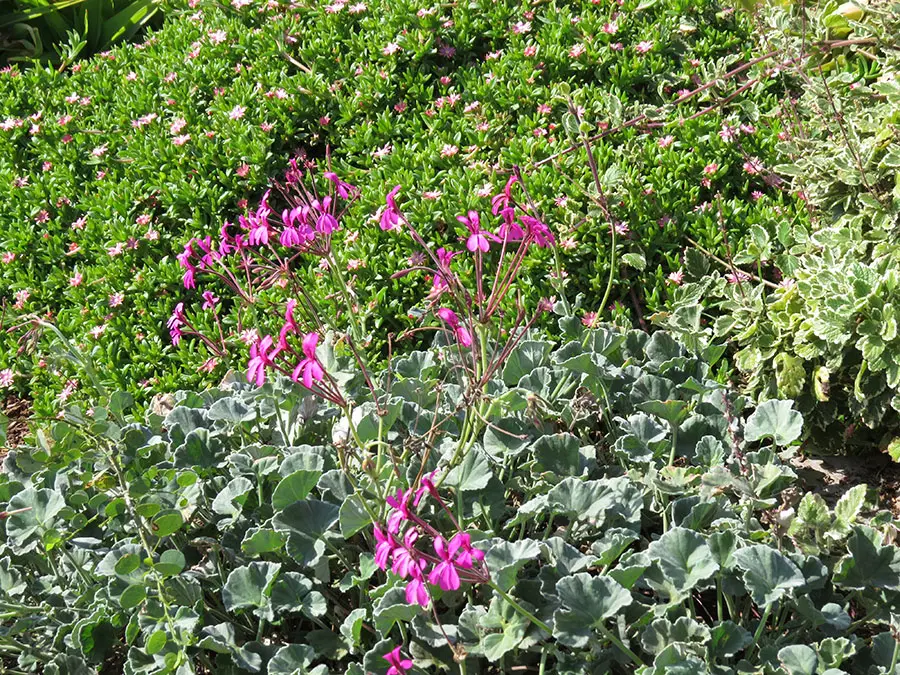
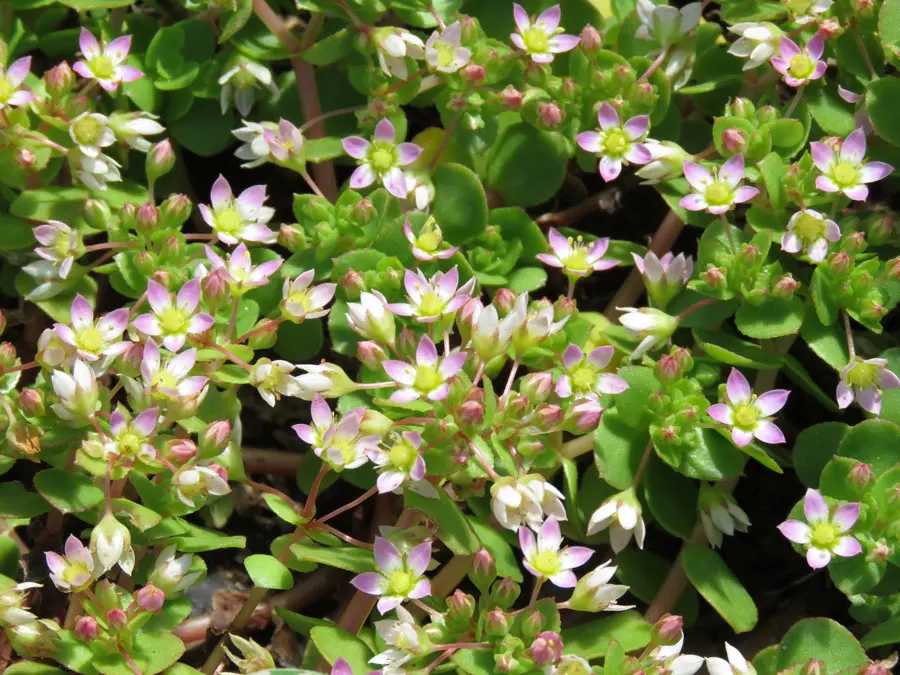
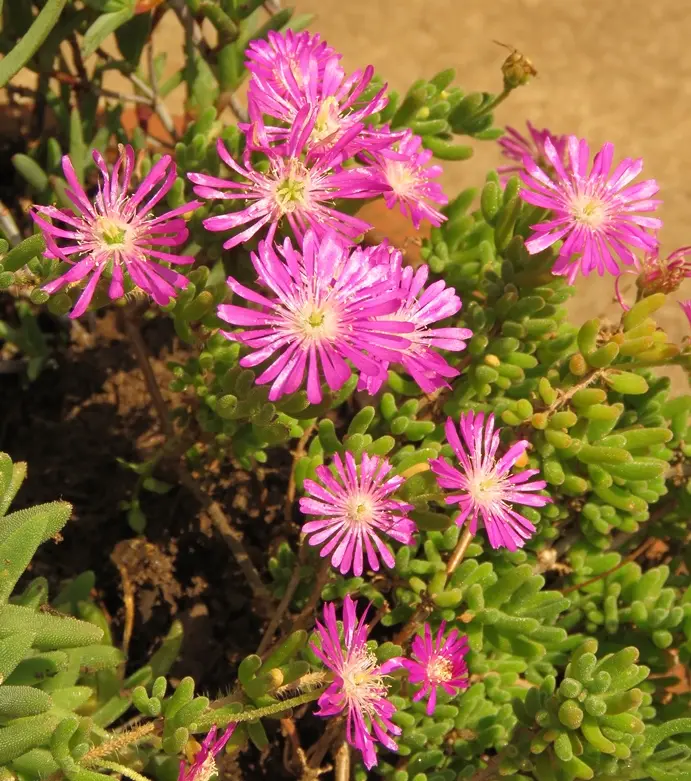



Comments